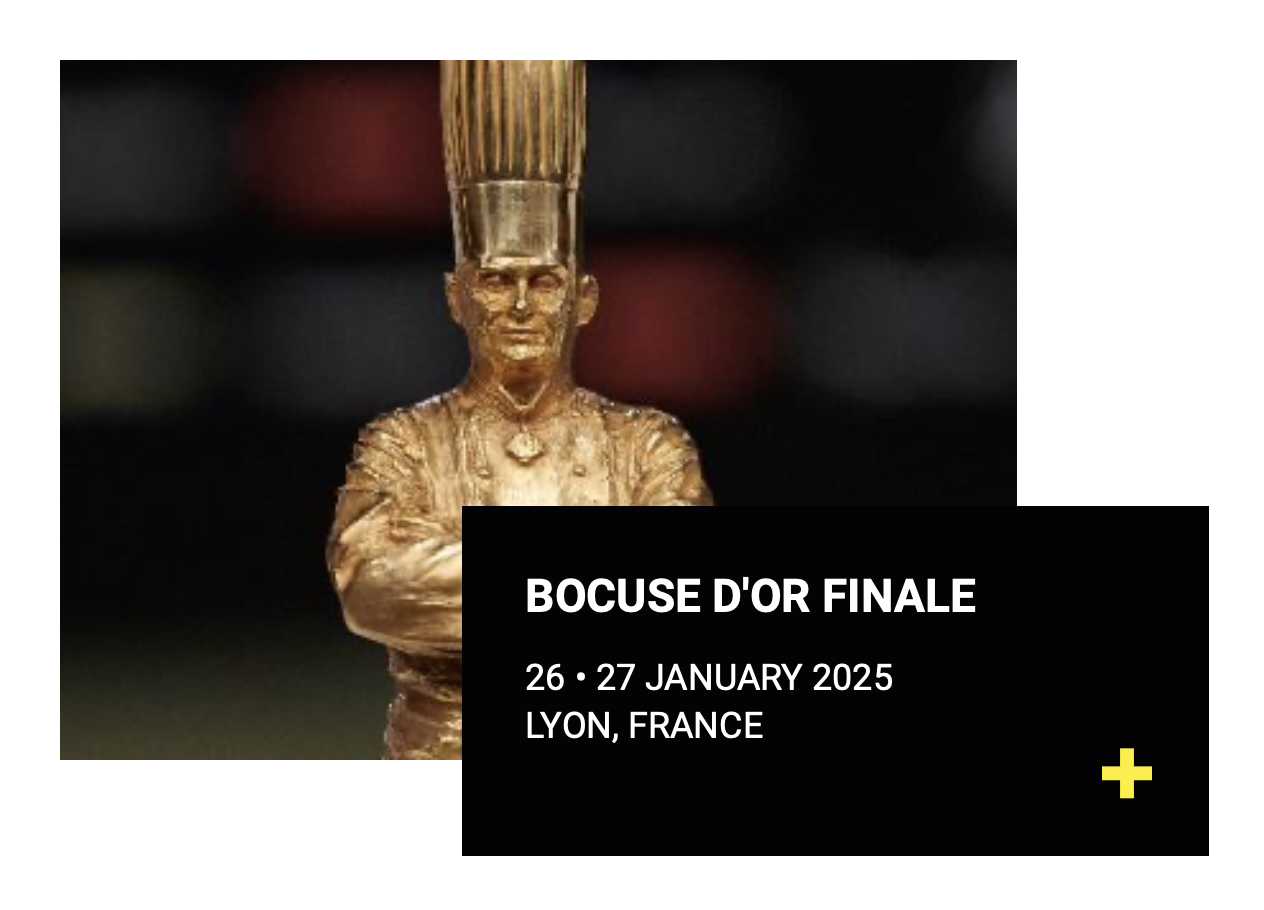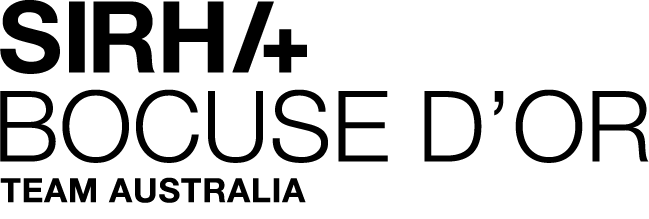
It’s known the world’s most prestigious culinary contest, is often referred to as the Olympics of cooking, and is attended by a who’s who of chefs and hundreds of media. It’s the Bocuse d’Or Grand Final, and it’s on in just a couple of weeks, from 26-27 January.
Held in Lyon, France, every two years at the SIRHA International Hotel, Catering and Food Trade Exhibition, the Bocuse d’Or (Golden Bocuse) has evolved over the past four decades to become the most sought-after title in the culinary world. At stake is a gold statuette of the competition’s founder, iconic chef Paul Bocuse, who died in 2018.
More than a culinary competition
The Bocuse d’Or (pronounced bo-cooz door) is more than just a cooking competition. It is a live event that breaks new ground in culinary innovation and excellence.
Organisers describe it as “an incubator of talent where commitment, passion, technique, and creativity reveal the greatest chefs of tomorrow. It is a unique springboard for those who wish to achieve international recognition.”
While the dishes are too elaborate and labour intensive to be replicated in any restaurant, the trends and innovations that grace the stage at the Bocuse d’Or trickle down to find their way onto menus around the globe. The contest has elevated or launched the careers of chefs, many of whom own or work in Michelin-starred establishments.
True to M. Bocuse’s vision of a cooking event like a sporting final, the Bocuse d’Or is held in a stadium-like atmosphere with supporters from each of the 24 countries loudly barracking for their team.
“The cheering crowd, the many cameras and media, and the level of expertise required make it unlike any other cooking competition in the world,” says Australia’s President Scott Pickett, who competed in 2005.
The Road to Lyon
Dubbed ‘The Road to Lyon’, there is a clear path to being among the 24 competitors at the Bocuse d’Or Grand Final. Every two years over 60 countries hold a national selection contest to select their lead chef.
Next they compete at a regional competition in Europe, The Americas, Africa or Asia Pacific. The 24 grand finalists comprise the top 10 teams from Europe, the top five from Asia Pacific and The Americas, two from Africa and two wild card entrants.
The 24 countries selected for the Bocuse d’Or 2025 are:
Asia Pacific: Australia, China (wild card), Japan, New Zealand, Singapore, Vietnam
The Americas: Canada, Chile, Colombia, Mexico, USA
Africa: Morocco, Mauritius
Europe: Denmark, Finland, France, Hungary, Iceland, Italy, Latvia (wild card), Norway, Slovakia, Sweden, UK.
The teams
Each team is headed up by the lead chef, assisted by a commis chef who can be no older than 22 years on the day of the competition. Their coach stands at the pass throughout the competition but not enter the kitchen ‘box’.
Teams are also represented on the judging panel, with a ‘jury member’ who judges either the first or the second challenge on both days of the contest. The Jury member is typically the nation’s Bocuse d’Or President, however rule changes in recent years mean that no chef can be on the jury for more than two consecutive contests.
Starting at 15 minute intervals, each team has five and a half hours to complete two challenges, or ‘themes’, each with its own mandatory ingredients and conditions.
Plate theme
The first challenge, to be presented for judging after four hours and forty minutes, is the ‘plate theme’.
This year’s ingredients, revealed in November, are celeriac, celery (including leaves), stone bass and lobster.
In a surprise twist, the celeriac must be presented first on a platter as two identical whole pieces representing eight portions each, accompanied by 16 identical individual garnishes made from celery. The 16 portions must then be presented on a plate, with the lobster and stone bass, plus a hot sabayon sauce based on lobster.
Training and recipe development using these ingredients is a challenge for Australia and other southern hemisphere-based teams, with celeriac out of season and European stone bass not available here. Even the lobster that will be supplied for the contest is a different species to the lobster available in Australia.
Platter theme
Mandatory ingredients for the second challenge, or platter theme, were revealed in September. They are venison saddle from roe deer, foie gras and either black, oolong or smoked tea. In addition each platter must feature a ‘national tribute’ highlighting a fruit from their home country.
Organisers say the ingredients are a tribute to Paul Bocuse “whose passion for hunting and exceptional products was known to all”.
Presented on an elaborate platter, the bone-in back of venison must be in three main pieces, along with two garnishes, or small side dishes. The first garnish must be a venison and foie gras pie, the second a hot, fruit-based garnish with the country’s chosen fruit, while the third garnish is to be 16 two-coloured sealed ravioles, served hot, with free stuffing accompanied by a clarified consommé of venison, served in a container supplied by sponsor All Clad, then flavoured with tea served in a teapot.
Once again, sourcing the main ingredient of bone-in back of venison has proved a challenge for Team Australia.
The prizes
It must be said that the main prize – The ‘Bocuse d’Or’ or golden statue of Paul Bocuse – is the most coveted trophy for chefs around the world. Second place receives the Silver Bocuse, and third receives a bronze trophy.
There is immense prestige attached to standing on the Bocuse d’Or podium and joining an exclusive club called, fittingly, Bocuse d’Or Winners.
In addition there is a cash prize of €20,000 for gold, €15,000 for silver and €10,000 for bronze. While obviously welcomed, the cash prize is a tiny fraction of the many hundreds of thousands of dollars/euros spent by teams who to reach these lofty heights.
The playing field
While a global event entered by over 60 countries, the Bocuse d’Or is overwhelmingly a European contest, with the medal count dominated by France and Scandinavia. France has won eight times, Norway five times, Denmark three and Sweden once. Luxemburg won the second competition in 1989 with the only female winner to date, Léa Linster. The only non-European winner is USA’s Mathew Peters, who claimed the trophy in 2017.
Australia punches well above its weight when the constraints of budgets, seasonality and ingredient availability is taken into account.
For example, while the Australians are all volunteers with their own restaurants or senior chef roles, the Swedish team funds eight people to work on the Bocuse d’Or full time for the whole two year cycle. Government and private sector funding for place-getting teams can run to the millions to ensure the best talent, equipment and ingredients, as well as the most precious and intricate platter.
“Just being one of the 24 teams selected for the Grand Final is an enormous achievement,” explains Bocuse d’Or Academy Australia’s Executive General Manager Tom Milligan, who competed in 1995 and has also served as Vice President, President and Jury Member.
He says Australia has been represented in Lyon every year since 1989, except in 2021 due to the pandemic. In 2017 Dan Arnold achieved our best ever result at eighth place, and he also won Bronze at the Bocuse d’Or Asia Pacific 2016.
An exceptional year
“2025 is an exceptional year for Team Australia,” says Tom. “It’s 20 years since Dan’s mentor, Serge Viera, won the Bocuse d’Or in 2005. Our President and Jury member Scott Pickett also competed that year, and Dan is competing in Serge’s honour.
Tom adds that it is 30 years since he competed in the 1995 Bocuse d’Or, which was won by French chef Régis Marcon.
“This year Régis’ son Paul Marcon is representing France, and my own son Chris Milligan is Australia’s commis chef. It is a beautiful circle and true to the Bocuse d’Or ethos of passing on your passion to future generations.”
